Learn About The Science Behind Clouds - Includes A Fun Experiment
I live in South Africa, in Durban to be exact, and we have just entered into Spring, our rain season! This afternoon we were blessed with a majestic thunderstorm and much needed rain. The sky in all its glory spurred on the idea of compiling a lesson plan for teachers that revolves around how clouds are formed and the different types of clouds you get. I still believe in the notion that children learn best through observation and experience, so I have also included a simple little science experiment that you can do with your students to help them grasp the science behind cloud formation.
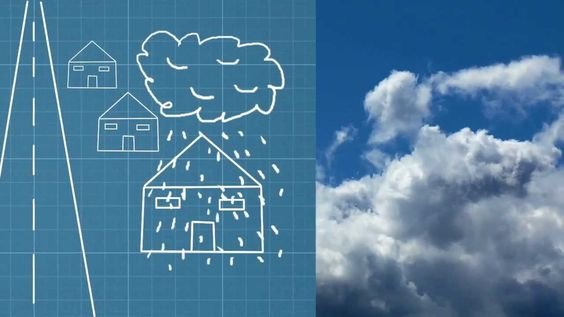
The Lesson
I always try to get students to observe the "real deal" in my lessons as often as possible. So with this lesson I encourage you to start off by taking the kids outside on a cloudy day to observe the sky and take notice of the clouds. A lovely activity for both younger and high school kids is to let them lie on their backs outdoors on a cloudy day. They are then asked to use their imaginations and transform clouds into every-day objects, by paying particular attention to the shape each one forms. This also helps us appreciate this wonder of nature that we all too often take for granted and just accept as "one of those things".
If you are giving this lesson to primary school aged kids, you could also incorporate some nice stories about clouds into your lesson. Here are three awesome recommendations:
1. Fluffy, flat and wet - by Dana Rau
2. The man who named the clouds - by Julie Hannah and Joan Holub
3. Misty, the proud cloud - by Hugh Howey
Explaining What Clouds Are And How They Are Formed
Clouds are a group of very small water droplets or ice crystals that float in the air. These droplets are able to float in the air because they are lighter than air. Clouds are formed when water from the ground evaporates and rises (remember, warm air rises, cold air sinks). Once this water-vapor rises, it cools again and starts to condense to create water particles. The water particles group together to form clouds and once they become too heavy, they fall to create rain.
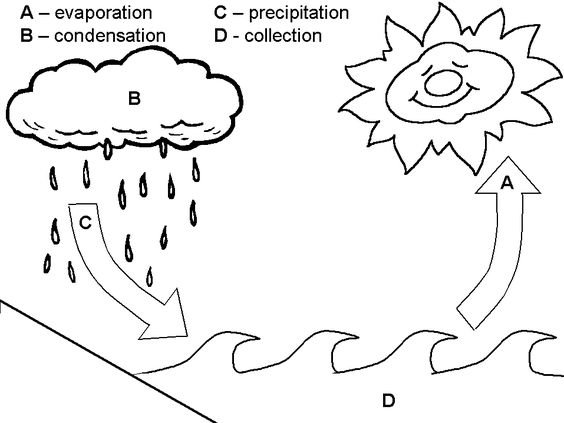
A List Of The Different Clouds You Get
Start by asking your students if they think clouds all look the same. Move on to explain to them that clouds actually come in all different shapes and size and that they can predict the weather depending on their state. Use this poster to help explain the different types of clouds you get:
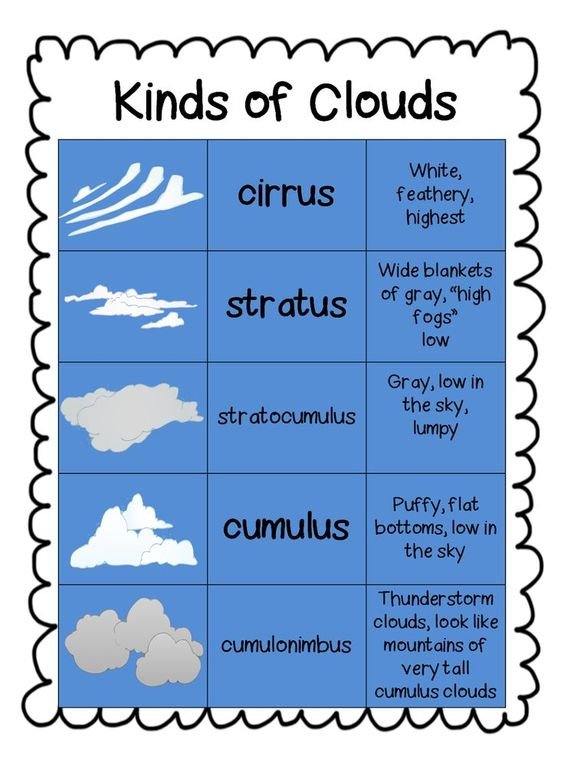
- Cirrus Clouds - They are made of ice particles and are quite narrow and wispy.
- Cirrostratus Clouds - These are large clouds that cover the sky like sheets, usually bringing rain.
- Cirrocumulus Clouds - These look like small puffs of smoke in the sky, usually in a row.
- Altostratus Clouds - They are either grey or blue and are a combination of rain and ice crystals and fill the sky.
- Altocumulus Clouds - These are big and puffy grey clouds and usually mean a big thunderstorm is brewing.
- Stratus clouds - these clouds look more like a thick mist in the sky and bring soft rain.
- Stratocumulus Clouds - These are grey and puffy clouds that are spaced out to show blue sky in-between.
- Nimbostratus Clouds - These are gloomy looking clouds that cover the sky in a thin layer, the bring heavy rain.
- Cumulus Clouds - These clouds look puffy and wispy, like candy floss. They indicate pleasant weather.
- Cumulonimbus Clouds - These clouds bring the heaviest rains, hail and even tornadoes. They are flat on top and and dark and grey.
A Worksheet To Use In Your Lesson - Print it >>>HERE<<<
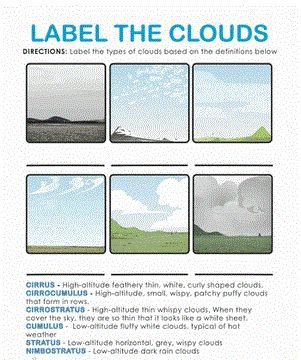
Experiment Time! How Do Clouds Make Rain?
This is a quick experiment and very easy to do, the materials are basic and inexpensive. It really give children (and adults too) an excellent observation on how clouds make rain and why we get rainfall.
You will need the following materials:
- A glass jar filled with water
- Shaving foam
- Blue food coloring
Instructions:
- Cover the top of the water in your jar with shaving foam, about 1-2 cm in thickness (this is your cloud)
- Drop the food coloring in slowly until it starts to fall through, like rain.
Explain that this is how rain works too. The water collects in the cloud until there is too much, and then it leaks through, forming rain. - http://thehappyhousewife.com
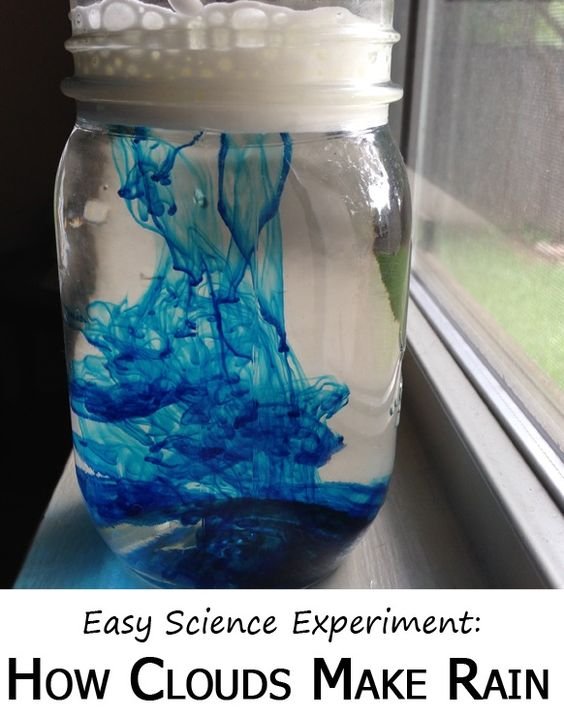
The explanation:
When water droplets and ice crystals continue to collect in a cloud, they get heavier and heavier. They will eventually become too heavy to float on the air. Water droplets will fall to the earth as rain.
As I said before, this lesson is so lovely in that it allows children to spend time outdoors observing nature and science. It allows them to grasp how evaporation, condensation and precipitation occurs, building logic and understanding at the same time. I hope you have as much fun with this lesson as I did! Enjoy your "cloudy" days!
 Team South Africa banner designed by @bearone
Team South Africa banner designed by @bearoneMuch love - @sweetpea
(bringing you original content)
Nice experiment :)
What ingredients do you have?
Good article
Another lovely informative post @sweetpea used to love watching storms over the sea, of late they appear to come over too fast and furious, must be my age.
That's a lovely and easy experiment. Thanks a lot!
Congratulations! This post has been upvoted from the communal account, @minnowsupport, by sweetpea from the Minnow Support Project. It's a witness project run by aggroed, ausbitbank, teamsteem, theprophet0, someguy123, neoxian, followbtcnews/crimsonclad, and netuoso. The goal is to help Steemit grow by supporting Minnows and creating a social network. Please find us in the Peace, Abundance, and Liberty Network (PALnet) Discord Channel. It's a completely public and open space to all members of the Steemit community who voluntarily choose to be there.
I used to love experiments when I was at school.
We also had some nice showers in Pretoria last night!!